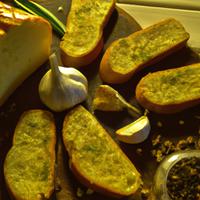
1 serving (100 grams) contains 350 calories, 8.0 grams of protein, 15.0 grams of fat, and 40.0 grams of carbohydrates.

Log this food in SnapCalorie

Nutrition Information
Calories |
841.3 | ||
|---|---|---|---|
% Daily Value* |
|||
| Total Fat | 36.1 g | 46% | |
| Saturated Fat | 16.8 g | 84% | |
| Polyunsaturated Fat | 0 g | ||
| Cholesterol | 24.0 mg | 8% | |
| Sodium | 1442.3 mg | 62% | |
| Total Carbohydrates | 96.2 g | 34% | |
| Dietary Fiber | 4.8 g | 17% | |
| Sugars | 4.8 g | ||
| protein | 19.2 g | 38% | |
| Vitamin D | 0 mcg | 0% | |
| Calcium | 120.2 mg | 9% | |
| Iron | 4.8 mg | 26% | |
| Potassium | 192.3 mg | 4% | |
* Percent Daily Values are based on a 2,000 calorie diet. Your daily values may be higher or lower depending on your calorie needs.
Food Attributes
Source of Calories
About Frozen garlic bread
Frozen garlic bread is a convenient and flavorful product inspired by Italian cuisine. Typically composed of sliced baguette or bread, it is coated with a mixture of butter or margarine, minced garlic, and herbs like parsley. Some varieties may include cheese for added richness. Frozen garlic bread is pre-prepared and designed to be baked straight from the freezer, offering a quick and tasty side dish or appetizer. Nutritionally, garlic provides antioxidants and potential immune-boosting benefits, while herbs add freshness and vitamins. However, frozen garlic bread is often high in saturated fats and sodium due to the butter and preservatives, making it a less ideal choice for frequent consumption. Opting for whole-grain varieties or those with reduced sodium can make it slightly healthier. While indulgent, frozen garlic bread remains a popular comfort food that pairs well with soups, salads, and pasta dishes.



